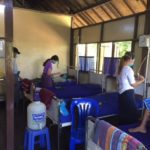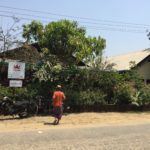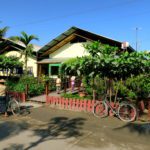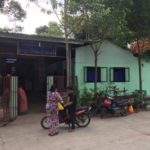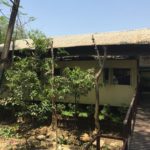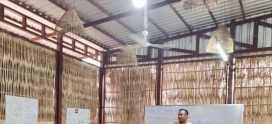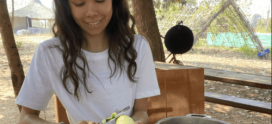Ed Wilkins in Myanmar- Week 36
Keeping with my pledge of last week, I’m going to get straight into the “what on earth would be the reason for coming out here” bit when you’re superiors keep informing you that what lies ahead is a promising and stratospherically rising career to your final position whether it be head poncho doctor, nurse, pharmacist, accountant, lawyer, computer whizz, or indeed undecided thinking being.
And of course, there is no single reason, just the same as it is with many essentials (like the love-of-your-life choice), a pit of the stomach desire to get on with it when it seems the right time. And not just for yourself, but to fulfil a bit of that teenage romantically noble dream, to provide help where help is really needed and, therefore, all you need now is that cliff-edge nudge from the main highway to success and follow that riskier yellow brick road to the airport. Hmm, just re-reading that and I can tell I’ve had too many espresso’s this morning but, hey-ho, the rule one for bloggers is never press that delete button. So, with that tediously long prefix to what’s to come, here are my reasons. And sorry if I’ve said all this before but sometimes months slip by so seamlessly that I forget when I last issued forth my ‘volunteering mantra’.
First there are the goodbye and good riddance pluses. For most healthcare workers, that’s the mind-numbing long and anti-social hours; the last-minute and holiday ruining immutable rotas; the unforgiving nature of the training programme and the scramble to get everything ticked off in time; the lack of ward-teaching because the consultants are ‘too busy’ on courses (management, appraisal, how to look important, or golf); the reds on your mandatory training – such as the fire lecture – are building up; the parking tickets for not forking out for the downright outrageous necessity to pay to use the staff car-park for work are mounting up; and the feeling everyone’s too stressed to have time to talk to patients which, by definition, a caring profession should be doing and after all is why you went into medicine.
On the Myanmar golden-buddha side, the patients you see are as sick as you’ve ever seen and never waste your time; your knowledge and skills, however limited, can improve care and sometimes save lives; your willingness to help is openly and smilingly appreciated; you learn about a new people, a new way of life, taste new and sometimes dubiously uncertain foods with undesired consequences, and meet new friends; you see medicine you rarely see in the UK; you have tales to tell when you return to blighty; and of course your view on life and medicine will never be the same. From being just another training number, you become a trusted and valued member of a team of like-minded volunteers from all parts of the world and all walks of life. So, go for it!!
Okay non-medics, time for another skip-over paragraph but everyone else let me take you on a few clinic and ward highlights. There’s a young lady whose TB meningitis only became obvious when her immune system jolted into life after starting HIV therapy and recognising that this beast of a bug didn’t belong, made an inflammatory fuss causing the meningitis and to-boot lumps in her head to stop twiddling their happy thumbs and come to life. Result, she became super-sick with severe weakness of her right side and a stiff neck. Here’s what happens with high-dose steroids to dampen this host-derived inflammatory response (picture 1): a happy and strong patient.
Staying with the ward, two patients were seen in the same morning with resistant TB of their lung. The key point of the picture is that transmission to the healthcare staff is a real problem so highly efficient face-masks must be worn and the efficiency of the mask must be tested before the staff can look after patients (picture 2). And this morning a patient just diagnosed with HIV on partner screening, but which is not too advanced underwent standard pre-treatment work-up which revealed that he had high BP, dependant oedema, significant amounts of protein in his urine, and bloods confirming moderate renal failure. So, in a nutshell, his bloods have led us to an equally important disease which may prove more of a problem than his HIV. In the West it’s usually the reverse. The last clinical vignette is of a brave young lad who never stops smiling who was born with a very deformed leg and has an above knee amputation (picture 3). Every year he goes back and gets a slightly longer fatter one: not certain whether there is anything more technologically advanced or better coloured, but he doesn’t let it bother him.
So, don’t let me lead you to believe for one moment that MAM is just about clinic care. There is an enormous development of community health care workers (equivalent to the bare-foot doctors) throughout the country who have been trained to be the first-line of care and through carefully defined algorithms can arrive at giving correct advice, issue a limited number of drugs from a prescribing list, or refer to hospital (which may not be easy). Where they work is usually in the most remote areas often unreachable during the rainy season for several months (picture 4). An ongoing pilot project is rolling out Smart phones with an installed programme of algorithms for 11 common presentations over 5 age groups which facilitates this (picture 5). There are now over 2500 ‘community workers’ and this is an enormous and complex management operation so maintaining sponsorship for all these activities is high and life-saving stakes (picture 6).
Now volunteering isn’t all about slogging your intestines out; after all that’s the responsibility of Burma’s wide range of enteric bugs. Instead, the need for a bit of liver-beating is also taken seriously by many of the younger volunteers who in the serious quest of fulfilling this consume prodigious amounts of liquor. So potential volunteers, you’re not lonely if you like a bit of company. Pictured are two nurses, two medical students, one doctor, one logistician, and the last one working on keeping the sponsors happy. All very different, all volunteering their time gratis from 3 months to a year, and excepting the non-healthcare personnel, all drinking large amounts of alcohol (which says something I think) (featured image).
Time to finish this so that I can leave something to chat about next time. Here are the four clinics in Yangon that I rotate my clinical time around as you will probably if you get on that plane. They are named after exotic flowers: Lotus (figure 8), Orchid (figure 9), Rose (figure 10) and Jasmine (figure 11).
Varying in patient cohort size, ward day case capacity, and patient cohort and activity, they are all based upon the same principle of providing local and total free healthcare for all, irrespective of wealth, religion, or ethnicity. Reminds me of a ‘once upon a time’ slogan back home doesn’t it?!



